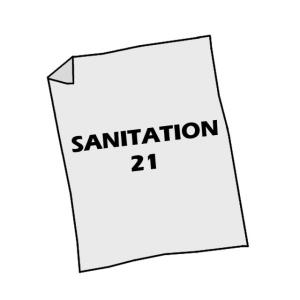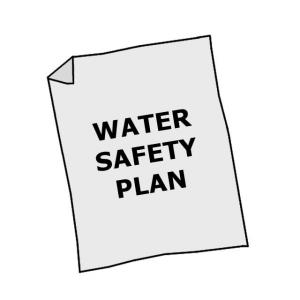An aerated pond is a large, mixed aerobic reactor. Mechanical aerators provide oxygen and keep the aerobic organisms suspended and mixed with water to achieve a high rate of organic degradation.
| In | Out |
|---|---|
Blackwater, Faecal Sludge, Greywater, Brownwater, Faeces, Excreta |
Sludge, Fertigation Water, Biogas (if anaerobic pond is covered) |
Increased mixing and aeration from the mechanical units means that the ponds can be deeper and tolerate much higher organic loads than a maturation pond (see waste stabilisation ponds). The increased aeration allows for increased degradation and increased pathogen removal. As well, because oxygen is introduced by the mechanical units and not by light-driven photosynthesis, the ponds can function in more northern climates.

Influent should be screened and pre-treated to remove garbage and coarse particles that could interfere with the aerators. Because the aeration units mix the pond, a subsequent settling tank is required to separate the effluent from the solids.
The pond should be built to a depth of 2 to 5 m and should have a detention time of 3 to 20 days, depending on the treatment target.
To prevent leaching, the pond should have a liner. This can be made from clay, asphalt, compacted earth, or any other impervious material. A protective berm should be built around the pond, using the fill that is excavated, to protect it from runoff and erosion.
The pond is a large expanse of pathogenic wastewater; care must be taken to ensure that no one comes in contact with or goes into the water. The aeration units can be dangerous to humans and animals. Fences, signage, or other measures should be taken to prevent entry into the area.
Permanent, skilled staff is required to maintain and repair aeration machinery and the pond must be desludged every 2 to 5 years.
Care should be taken to ensure that the pond is not used as a garbage dump, especially considering the damage that could result to the aeration equipment.
A mechanically aerated pond can efficiently handle concentrated influent and significantly reduce pathogen levels. It is especially important that electricity service is uninterrupted and that replacement parts are available to prevent extended downtimes that may cause the pond to turn anaerobic.
Aerated ponds can be used in both rural and peri-urban environments. They are most appropriate for regions with large areas of inexpensive land located away from homes and businesses. Aerated lagoons can function in a larger range of climates than Waste Stabilization Ponds and the area requirement is smaller compared to a maturation pond.
Notes in the Design and Operation of Waste Stabilization Ponds in Warm Climates of Developing Countries
Anaerobic, facultative and maturation ponds as wells as aerated lagoon systems are presented as an appropriate solution in developing countries where sewerage systems are present. The technical content was reviewed by Prof. Duncan Mara (University of Leeds, England). Detailed design, operation and maintenance guidance is given. Hence, this paper can be useful as a technical manual.
ARTHUR, J.P. (1983): Notes in the Design and Operation of Waste Stabilization Ponds in Warm Climates of Developing Countries . (= World Bank Technical Paper , 7 ). Washington: The World Bank URL [Accessed: 08.05.2018] PDFSmall and Decentralized Wastewater Management Systems
Decentralised wastewater management presents a comprehensive approach to the design of both conventional and innovative systems for the treatment and disposal of wastewater or the reuse of treaded effluent. Smaller treatment plants, which are the concern of most new engineers, are the primary focus of this book.
CRITES, R. TCHOBANOGLOUS, G. (1998): Small and Decentralized Wastewater Management Systems. New York: The McGraw-Hill Companies Inc











